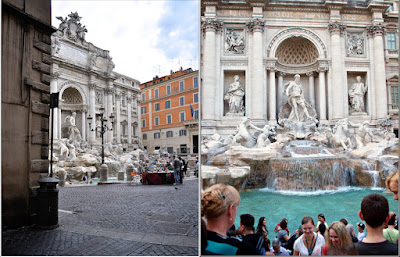Arrive in Rome. Drop everything. Go straight to the Pantheon.
It has been astonishing visitors since the 1st century.
Behind the Pantheon is the Basilica of Santa Maria Sopra Minerva (Saint Mary over Minerva).
Its plain facade conceals Rome's only intact Gothic interior.
Bernini sculpted the small elephant out front.
Sant’Ignazio di Loyola, five minutes east of the Pantheon, has Andrea Pozzo’s “Apotheosis of Saint Ignatius” on the ceiling. It was painted to be seen from a spot marked on the floor by a star.
Stand on the star and see if you can tell us where the architecture leaves off and the painting begins.
A view of the ceiling from the “wrong” end of the church reveals it is painted on a barrel vault.
Just north of the Pantheon, Santa Maria Maddalena has an exuberant Rococo exterior.
The dome within was designed by Carlo Fontana in 1653.
Across Piazza Maddalena is the high-end butcher Angelo Feroci.
Your photos of their magnificent food displays will turn out.
You can find four paintings by Caravaggio just west of the Pantheon. Sant’Augustino has his “Madonna of Loretto”.
Caravaggio's realistic depiction of the peasant's dirty feet shocked his contemporaries.
In 1600, Caravaggio set Rome on its ear when he unveiled his Saint Matthew trilogy of paintings in San Luigi dei Francesi, just south of Sant’Augustino.
They were a triumph for the 29 year old artist. People crowded around to see them then and we are still crowding around.































































